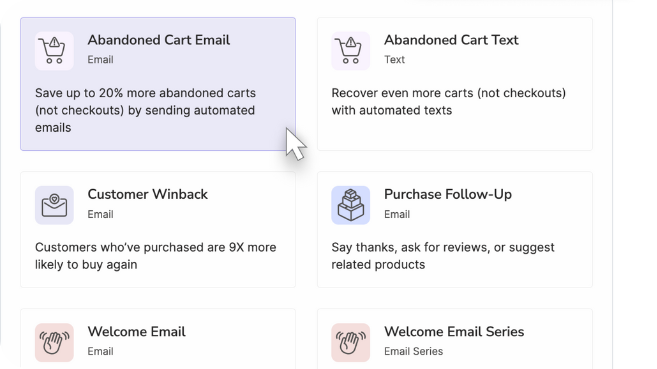The #1 Thing You Can do to Improve Your Email Deliverability
5 min read time
Published on Feb 3, 2022
Written by Jess Iocca

You want your marketing emails to land in your contacts’ inboxes.
And you want those contacts to engage with your emails.
But here’s the thing. The email address you send your marketing emails from plays a huge role in your ability to do both of these things.
As you’re building up your email marketing efforts, it can be easy to overlook this critical detail.
So we’re here to tell you: setting up your own custom sending domain is the #1 thing you can do to help your brand’s email deliverability.
Get our best content on ecommerce marketing in your inbox 2 times a week
What exactly is email deliverability?
To build a successful ecommerce store, there's a ton to think about.
So it makes total sense if “email deliverability” is one of those things that you’ve seen a few times, but never really dug into.
Your email deliverability rate tells you how many emails successfully land in your contacts' inboxes, without bouncing or being marked as spam.
And more emails delivered means more opportunities to drive sales.
If you’re wondering what your email deliverability rate is, here’s how to calculate it:
Take the number of delivered emails, and divide it by the total number of emails sent. Then multiply that number by 100 to get your percentage.
And here’s the calculation as a formula for reference:
Deliverability Rate = (Delivered Emails/ Total Emails Sent) x 100
The good news is that Privy automatically calculates this for every email you send.
But there’s a catch...
Once your email lands in your contacts' inboxes, there’s still a chance it could end up in the spam folder.
That’s where your custom sending domain comes in.
What is a custom sending domain?
The simplest way to think about your custom sending domain is that it’s the email address your contacts receive your emails from.
So instead of getting emails with this in the “from” field:
Your contacts will get something that looks more like this:
Email service providers (ESPs) like Privy, have their own sending domains.
As you’re getting up and running with your ESP, your ESP’s sending domain will likely be set as the “from” address for your emails by default.
And unless you set your own custom domain, your emails will be sent “from” an email address like “offers@privymarketing.com.”
The chances of your recipients clicking the spam button on your email are a lot higher when they don’t recognize the sending address.
To get ahead of this, best practice in the world of email marketing is to set your own custom sending domain.
So when your emails reach the inbox, they're recognized as coming from a credible source, and not as spam.
How does a custom sending domain help with email deliverability?
We’re not exaggerating when we say that having your own custom sending domain presents a HUGE opportunity to improve your email deliverability.
And with improved email deliverability comes greater revenue potential.
Here’s how a custom sending domain can help your brand.
1. Have more control over your sending reputation
An ESP’s default sending domain is shared by any users who haven’t verified their own custom sending domain.
Which means multiple brands are sending emails from the same email address.
And what one user does with their email marketing can have an impact on other users, or brands, using the same sending domain.
This is one of those situations where the saying “one bad apple spoils the bunch” can ring true.
ESPs like Privy have a ton of measures in place to meet compliance standards to prevent users’ emails from landing in the spam folder.
But things like subject lines with too many characters or emails with too many images can hurt the reputation of a shared sending domain.
And a small number of users who aren’t following best practices can end up impacting your brand’s ability to successfully deliver emails.
A custom sending domain is all your own, no sharing with other businesses.
Not only do you have much more control over your recipients’ experience, your sending domain’s reputation is yours to build and protect.
Which is a huge win for your brand.
Because when your emails hit inbox service providers (ISPs), like Gmail and Hotmail, your emails will appear as coming from your brand, rather than a shared domain like privymarketing.com.
The ISPs will associate your email activity with your custom domain, and no longer take into account the activity from other brands like they would with a shared domain.
So if you’re following email best practices, your chances of landing in your contacts’ inboxes, and not their spam folders, will increase.
2. Increase brand awareness and build trust
Your contacts sign up to hear from your brand.
So they expect to receive emails from yourbrand.com, not privymarketing.com.
And with all the time and effort you spend crafting your emails, you don’t want one detail like your “from” address to get in the way of your contacts actually seeing your emails.
With a custom sending domain, every time your emails hit your contacts’ inboxes, they’ll recognize your brand.
And the more they see your name, the more memorable your brand will be in their minds.
A custom sending domain signals that your business is professional and gets your emails in front of your contacts consistently.
3. Improve email engagement and drives sales
If you’re thinking that a contact who recognizes your brand in their inbox is more likely to engage with your emails, you’d be correct.
According to a survey by Google, 60% of businesses that switched to a custom sending domain saw an increase in customer engagement and 42% saw an increase in sales.
Driving more sales is the ultimate goal of ecommerce marketing. And the more engaged the contact, the more likely they are to buy.
Plus, increased email engagement is the gift that keeps on giving when it comes to email deliverability.
A recognizable sending address drives more email opens and clicks among your contacts.
Which, in turn, tells ISPs that your recipients trust you and boosts your sending reputation.
So the next time you send an email, ISPs know you’re credible. And the positive cycle continues.
How to set up your custom domain in Privy
Setting up your custom sending domain doesn’t have to be daunting.
Watch this five minute video with a step-by-step guide on how to set up your custom sending domain in Privy.
Subscribe for Updates
Get our best content on ecommerce marketing in your inbox 2 times a week.

Written by Jess Iocca
Jess joins Privy after completing her MBA at Boston University, where she specialized in marketing and social impact. She loves introducing her family and friends to small businesses and emerging brands, and is thrilled to put that passion to work at Privy. Outside of work, you can find Jess organizing her virtual book club and exploring new restaurants. Jess lives in Boston with her husband and their cat, Phoebe.
Subscribe for Updates
Get our best content on ecommerce marketing in your inbox 2 times a week.


.jpg)






